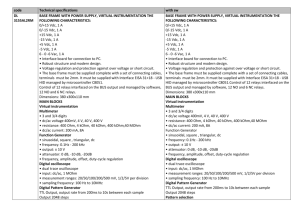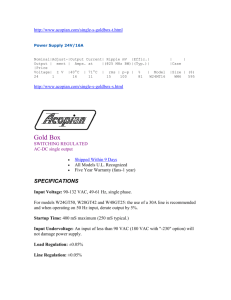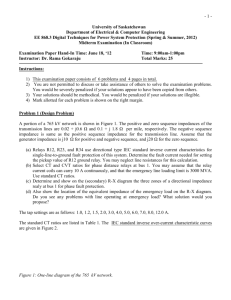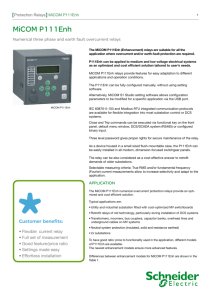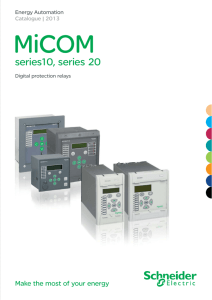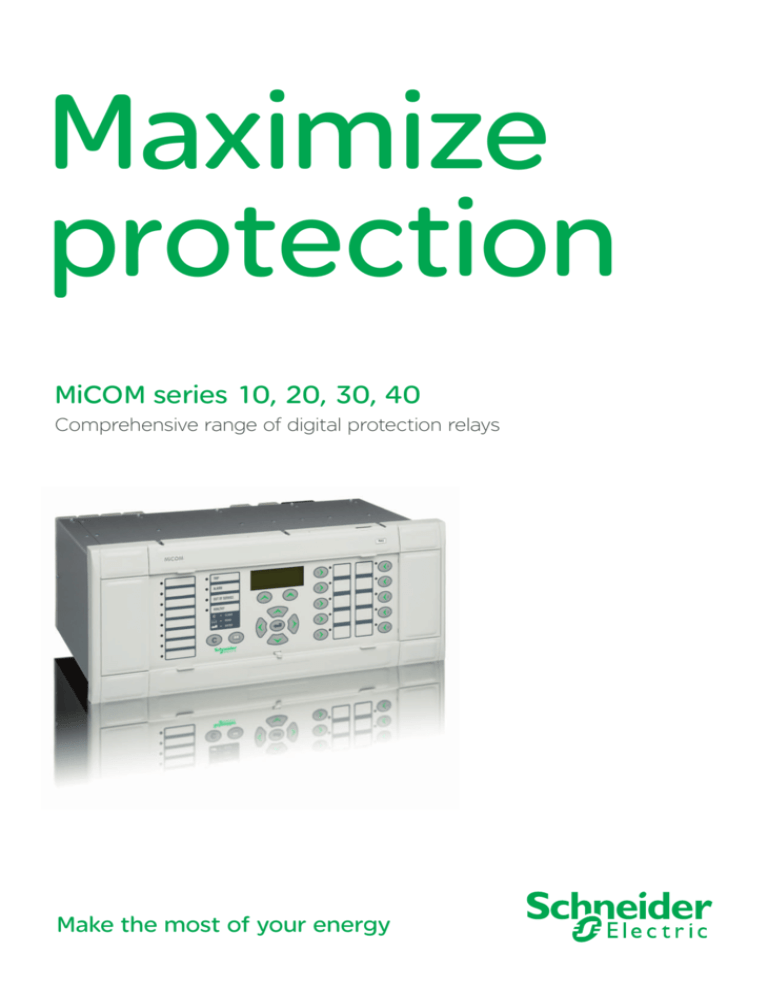
Maximize
protection
MiCOM series 10, 20, 30, 40
Comprehensive range of digital protection relays
Make the most of your energy
Increase
energy
availability
Maximize energy availability and the profits
generated by your installation while protecting
life and property.
100% available
energy
Fast response
Maximum
dependability
Your electrical equipment is under control.
With MiCOM protection relays, you get
maximum energy availability for your
process.
The MiCOM range of relays
1999
offers scalable levels of functionality and hardware options to best
suit your protection requirements, and allows you to choose the most
cost effective solution for your application.
The MiCOM protection relay range provides the capability for a
wide variety of protection, control, measurement, monitoring and
communication.
The versatile hardware and common relay management software
(MiCOM S1 studio) allows a simple configuration and installation in
different applications.
A standard and simple user interface across the entire range makes
MiCOM ideal in any environment, from the more complex bay
level control with mimic, to the most simple LCD display with menu
interrogation.
Launch of first
MiCOM relay
protection
Keep informed to manage better
2013
Over 500,000
MiCOM units
installed around the
world
Every MiCOM relay provides you with intuitive access to all system
information in your own language so that so that you can manage
your electrical installation effectively.
If a problem occurs, clear and complete information puts you in
a position to make the right decisions immediately. The electrical
supply is restored without delay.
Maintain installation availability
MiCOM relays maintain high energy availability thanks to their
diagnostics function that continuously monitors the network status.
In-depth analysis capabilities and high reliability ensure that the
equipment is de-energised only when absolutely necessary.
Risks are minimised and servicing time reduced by programming
maintenance operations.
03
02
Increase your capabilities...
... with a comprehensive range
From cost effective to high end protection and control, the
comprehensive MiCOM series allows complete optimisation
of your solution.
series 10
series 20
Feeder
P11x
P12x
MiCOM series 10
Motor
P21x
P22x
Fulfils the basic requirements of Buildings and small Industries
applications with particular focus on overcurrent and motor
protection. Two families are available.
• Auxiliary powered
• Self powered / dual powered.
Generator
MiCOM series 20
Fulfils the basic/medium requirements of Industrial, Utility and Building
applications providing simplicity and ease of use in a wide range of installations.
• Scalable solutions where type and quantity of protection features is model
dependent
• Flexible logic equations available on most models
• Compact hardware options for easy installation
• Common functions throughout the range
• Multi-language HMI
• Advanced protection functions
MiCOM series 30
Fulfils the protection requirements of Utility and Industrial applications with
particular focus on integrated feeder control and provides dedicated railway
protection devices.
• Protection with bay level control options to facilitate feeder management
• Input/Output quantity selectable based on requirements
• Numerous rear port communication hardware options available with a wide
range of protocols selectable via software
• Protection functions available for isolated/Petersen coil earthed systems
• Surface and flush mounted (including detachable HMI option) as well as
compact case models available in the range
• Full Programmable Scheme Logic (PSL) and function keys
P13x
series 40
P14x
P24x
P34x
Distance
Line differential
series 30
P52x
Transformer
P43x
P44x
P53x
P54x
P63x
P64x
Busbar
P72x
P74x
Breaker Failure
P821
P84x
Voltage
and frequency
P92x
Prefered
application
MiCOM relays fulfil the requirements at all voltage levels:
MiCOM series 40
Fulfils the protection requirements for a wide market of Utility
and Industrial application and offers a wide range of protection
functions.
04
• Full Programmable Scheme Logic available with graphic
configuration tool for easy setting
• Scalable Input/Output hardware depending on requirements
• Operating voltage selectable via software for opto inputs
• Hardware accessories available for easy mounting in racks or
panels.
05
Save time...
... with a simple operating software
The MiCOM S1 Studio programming and operating software provides a single
environment for the entire range. The result is a simple, user-friendly approach
for fast commissioning.
Configuration
Operation
Equipment
setup
Summary
of functions
Protection
activation
Upload data on-line
from the relay or
off-line from a data
model template
Automatic
hardware
description
Enable protection
functions
Easily and quickly
apply protection,
control and
monitoring settings
Application
compliance
Fine tune
capability
Setting file ready
to be downloaded
to MiCOM relay
download
export
Straightforward
facility for
commissioning
1 to 5 minutes
06
5 minutes
20 minutes
Analysis of
waveform
capture
Display, analysis and
printing of disturbance
recording data.
Real-time
supervision
Supervision of the status
of all the relays in the
electrical installation
Management
of alarms
and events
Complete peace of mind during operation
07
Protect your network...
Protect
... with a complete set of tools
Mesure
MiCOM protection relays were launched in 1999 using best-in-class protection techniques
now combined with latest technology to position MiCOM as a highly dependable range of
device.
MiCOM devices measure (and store) a wide comprehensive range of system values such as
Current, Voltage, Frequency, Power etc. from instantaneous or derived values.
Measurements can be displayed on the front LCD display or transferred via the
communication ports. The high accuracy measurement class transformers throughout the
MiCOM range provide data that you can rely on.
At Schneider Electric, these protection techniques are fine tuned to give you the best possible
protection for your assets. We also engineer quality into every device in line with best in
class standards to match our protection performance.
Our latest range of devices are better than they have ever been.
Records
Secure
Event records are generated by status changes to logic inputs, outputs, settings and alarms.
They are readily available for view on the LCD display, or extraction via the communication
ports. All records are time tagged to a resolution of 1ms and are maintained during auxiliary
supply interruptions.
Our comprehensive self monitoring provides peace of mind that errors are detected to ensure
high reliability for your plant and assets.
Fault records capture information including Fault number, date and time, active setting
group, function that issued the trip and measurement values. Disturbance records capture
the sampled values of all analogue inputs such as phase currents or voltages present during
the fault. Oscillographic analysis using MiCOM S1 Studio provides quick analysis of analogue
and digital signals on the same time-scale. They can be extracted from the relay via the
communication ports and saved in COMTRADE format.
Schneider Electric’s Cyber Security solution encompasses the entire substation, many
elements are now available.
Please contact your local Schneider Electric representative for availability.
Communicate
Local and remote communication is provided and designed for use with the MiCOM S1
Studio software. Rear communication port(s*) are intended for remote communication to
SCADA or engineering access.
Control
Fully programmable function keys and programmable tri-state LEDs (red/yellow/green)
are available on MiCOM series 30 and 40. Bay Control on selected series 30 devices is
provided on a graphical display with customizable mimic. MiCOM series 40 also provides
programmable hot-keys for direct menu access (e.g. Trip/Close command).
When an Ethernet card is installed in series 30 or 40 devices, IEC 61850 communication
is available for the latest in high speed communication and GOOSE messaging. Various
network architectures are supported including Parallel Redundancy Protocol (PRP) on series
40. All port types, quantities and protocols vary by product, please check the order form for
availability.
Time synchronisation of the internal real-time clock can be implemented from various sources
including an optional IRIG-B port (MiCOM series 30, Compact and 40) or communication
protocol (protocol and device dependent).
*Optional rear communication port on many relays.
Setting
Logic
Setting is achieved with the MiCOM S1 Studio support package. The intuitive support
software is all you need for the management of your entire MiCOM installed base, which
manages all setting files with its unique substation file management facility.
The in-built datamodel manager also ensures that you always have the latest support files
installed on your computer for all of your devices. Multiple independent setting groups are
supported in most MiCOM relays, they can be activated locally, remotely or via a dedicated
input condition, to allow for different system operating conditions or adaptive relaying.
08
Programmable scheme logic is configured using the MiCOM S1 Studio. MiCOM series
20 uses Boolean equations, whilst series 30, Compact and 40 use graphical programming
(series 30 and Compact can use either method). Flexible logic in most series 20 relays
allows users to create equations to be assigned to LEDs, outputs, trips, alarms or back
into other equations. Programmable graphical logic in MiCOM series 30 and 40 relays
are an extremely powerful tool. Users can customise protection and control functions or
add additional supervision or custom schemes, e.g. trip circuit supervision or frequency
restoration. This logic is event driven to ensure that protection is not delayed.
09
Simplify your operation...
MiCOM series 10
... with a user friendly interface
MiCOM series 30 in compact case
MiCOM series 30 with bay control
MiCOM series 20 and 40
1
1
5
1
2
5
2
3
2
4
3
3
3
1
5
4
2
4
8
9
4
6
6
7
6
The user interface and menu text is available in English, French, German and Spanish as
a standard. Other languages such as for example Russian and Chinese are supported on
some relays depending on the market requirements.
5
7
6
User language options that provide true global convenience
The ability to customize the menu text and alarm descriptions is also supported on series
30 and 40.
The front panel user interfaces comprises:
1
2
3
A back-lit liquid crystal display (series 10, 20, 30, 40)
Graphic LCD display (series 30)
5
“READ” and “CLEAR” keys for viewing and reset of alarms
6
3 fixed function LEDS (series 10)
4 fixed function LEDs (series 20, 40)
5 fixed function LEDs (series 30)
Front communication port
7
Facility for fitting a security seal
Up to 4 user programmable LEDs (series 20)
Up to 18 user programmable LEDs (series 30)
Up to 8 user programmable LEDs (series 40)
8
Programmable Function keys (compact case, series 30 and 40)
9
Switchgear control keys up to 6 bays control (series 30)
4
Menu navigation and data entry keys
10
11
Mechanical description
A
Case construction
The MiCOM series are housed in specially designed cases which provide a high density of functionality within the
product. Communication ports and model/serial number information is concealed by upper and lower covers on
certains models.
B
series 20
Physical protection of the front panel user interface and prevention of casual access is provided by an optional
transparent front cover (selected models only), which can be fitted or omitted, since the front panel has been
designed to IP52 protection against dust and water.
An option for surface mounting and a compact case is also supported on the series 30 for installations with space
limitations.
The differing case widths of relays can be combined with or without the use of standard blanking plates to form a
complete 19” mounting. This saves space and allows for a neat installation.
O UT O F SERVI CE
Front View
The cases are suitable for either rack or panel mounting.
TRI P
ALARM
HEALTHY
A
OK
EDI T M O DE
A
B
B
series 10
series 30
Dimensions
series
20
series
30
B
C
D
E
Compact 1
106.5
106.5
113
118
101.5
B
Compact 2
184
157
110
140
150
series 40
103
240
(incl. wiring)
139.8
223
270
(incl. wiring)
166.4
249.6
157.5
155.2
156
227.9
253.6
177.5
177
30TE
155
24TE
186.4
40TE
260.2
84TE
184,5
40TE Surface
481.6
40
84TE Surface
481.6
40TE
206
60TE
309.6
177
80TE
413.2
80TE Rack
483
D
177.5
C
series 10
240
(incl. wiring)
270
(incl. wiring)
157.5 max
E
C
E
D
series 20, 30 & 40
D
Compact case
Typical case dimensions
Wiring
series
30
E
260.2
257.1
series
Compact case
A
20TE
B
A (including brackets)
10
A
Side View
series
A
Compact
294.4
175.6
88.5
253
Compact
External connections are made via ring type terminal except on the compact case. These take pin type terminals
along with the series 30 relays as an option.
Note: Maximum sizes for guidance only, for specific product information please check the relevant product documentation. (All dimensions in mm)
12
13
Technical data description
General series data
series
series
10
Power supplies
A wide range of power supply options are available at the ordering stage.
Operate Range (V)
dc
ac
19-66
19–72
Nominal Voltage
Vnom.
24-60Vdc/ac
series
30
series
20
series
Standard case
Compact case
40
Frequency 50/60Hz
Dual rated 1A/5A *
Opto inputs
max 8
max 12
max 82
2
max 64
10
60-250 Vdc / 90-240 Vac
48-300
71-265
Output contacts
max 8
max 9
max 48
8
max 60
series
24-250 Vdc / 48-240 Vac
19.2-300
38.4-264
5A
5A
5A
10A
48-250 Vdc / 48-240 Vac
38.4-300
Continuous carry
5A
38.4-264
19-72
-
25A for 3s
30A for 3s
30A for 0.5s
30A for 0.5s
30A for 3s
30
24-60 Vdc
60-250 Vdc / 100-230 Vac
48-300
100-230
series
24-48 Vdc
48-110 Vdc / 40-100 Vac
19-65
-
37-150
32-110
LED indication
(freely programmable)
110-250 Vdc / 100-240 Vac
87-300
80-265
Function keys / Hot keys
20
series
Make and carry
High break contacts
8 (6)
8 (4)
29 (24)
17 (12)
22 (18)
No
No
6
4
10/2 **
up to 2
up to 8
4
4
4 (2)
Fault records
20
25
8
8
5
Digital Inputs
Event records
200
250
1000
200
250-512
A wide range of opto input voltages are supported throughout the range
Disturbance records
5 (6s max)
5 (15s max)
Programmable logic
No
Flexible logic **
IRIG B
No
Option
Alphanumeric
Alphanumeric
USB
(RS 232
RS 232
RS 232
RS 232
Yes/No
Yes/Option
Yes/Option
Yes/Option
Yes/Option
Courier
No
EIA(RS)485 **
Modbus
Yes
EIA(RS)485
IEC 60870-5-103
Yes
EIA(RS)485
No
No
DNP3.0
No
EIA(RS)485 **
EIA(RS)485
or fibre
EIA(RS)485
or fibre
EIA(RS)485
or fiber
EIA(RS)485
or fibre
EIA(RS)485
or fibre
K-Bus/ EIA(RS)
485 or fibre**
EIA(RS) 485
or fibre**
EIA(RS) 485
or fibre **
IEC 60870-5-101
EIA(RS)485
or fibre
EIA(RS)485
or fibre
EIA(RS)485
or fibre
EIA(RS)485
or fibre
EIA(RS)485
or fibre
IEC 61850
No
No
With Ethernet
No
With Ethernet
One box bay control
with mimic
No
No
Yes **
No
No
Pin or Ring **
Ring
Pin or Ring
Pin
Ring
40
Settings groups
series
10
series
20
Auxiliary Voltage
> 24 Vdc/ac
Thresholds (V)
> 19.2 Vdc/ac
> 90 Vac
> 71 Vac
> 90 Vdc
> 77 Vdc
24- 250 Vdc / 48-240 Vac
> 19.2 Vdc/ac (Variant code”Z”)
> 19.2 Vdc/ac (Variant code”Z”)
> 105 Vdc (Variant code “H”)
48- 250 Vdc / 48-240 Vac
> 77V (70% of Uaux. 110 Vdc; Variant code “V”)
> 154V (70% of Uaux. 220 Vdc; Variant code “W”)
Thresholds
series
30
series
40
Standard Variant
> 18 (Uaux. 24-250 Vdc)
Further Options
> 73 V (67% of Uaux. 110 Vdc)
> 90 V (60-70% of Uaux. 125/150 Vdc)
> 146 V (67% of Uaux. 220 Vdc)
> 155 V (60-70% of Uaux. 220/250 Vdc)
Universal programmable voltage thresholds
24/27, 30/34, 48/54, 110/125 and 220/250 Vdc
LCD display
Front port
Rear Port/2nd rear port
Terminals
* CT thermal ratings continuous: 4 In/10s & 30 In/1s & 100 In
** model dependent
14
8 (16.4s max) 8 (16.4s max)
75 s max.
Fully
Fully
Fully
programmable programmable programmable
Option
Option
Alphanumeric /
Alphanumeric
Graphical **
Option
Alphanumeric
No
EIA(RS) 485
or fibre**
15
MiCOM series description
Feeder management and overcurrent relays
10
series
model
P111 P114D
20
4
4
4
4
Opto Inputs ( max)
8
Output Contacts (max)
Output for striker triggering
2
2
6
4
4
7
1
1
1
P130C
P132
40
P139
P141 P142
P143
P145
40TE
40TE
60 or 80TE
60TE
model
Case size
20TE
20TE
20TE
20TE
30TE
30TE
30TE
1
4
4
4
1
4
4
4
4
4
5
5
5
5
CT Inputs
1
1
3
3
4 or 5
4 or 5
3
3
3 or 4
3 or 4
VT Inputs
4
7
12
2
70
70
8
16
32
32
Opto Inputs ( max)
9
8
32
28
8
15
30
32
Output Contacts (max)
2
5
2
5
3
7
5
9
7
9
24, 40 or 84TE 40 or 84TE
series
Compact
VT Inputs
8
30
P115 P116 P120 P121 P122 P123 P125 P126 P127
Case size
CT Inputs
Feeder management relays
Output for striker triggering
Magnetic flags (max)
5
Magnetic flags (max)
RTDs (max. option)
10
10
Analogue Input/ Output (max)
1/2
1/2
Bay Control & Monitoring
- with Mimic
Function Keys/Hotkeys
Bay Control & Monitoring
- with Mimic
Interlocking logic
PROTECTION FUNCTION
25
Directional power
32
Master sequence device
34
Undercurrent
37
Negative sequence overcurrent
46
47
Incomplete sequence relay
48
Thermal overload
49
3 Phase overcurrent
1 Phase or earth overcurrent
50/51N
50/51P
50BF
Motor
51LR
Over/Under voltage
Residual over voltage
66
Ground fault directional
67N
Sensitive directional earthfault
67N
Trip circuit supervision
Voltage transformer supervision
Neutral admittance
Function Keys/Hotkeys
Interlocking logic
32
Directional power
34
Master sequence device
37
Undercurrent
46
Negative sequence overcurrent
46BC
47
Negative sequence overvoltage
48
Incomplete sequence relay
49
Thermal overload
50/51N
Ground fault
50/51P
3 Phase overcurrent
51V
59/27
59N
Residual over voltage
64
Restricted earthfault
66
Startup monitoring
50/51P/N
67N
Ground fault directional
67N
Sensitive directional earthfault
67P
Phase directional
Wattmetric earthfault
67W
79
Autoreclose
81
Under/Over frequency
81R
85
86
SOTF
TCS
VTS
Over/Under voltage
Voltage controled overcurrent
Motor
CTS
Circuit breaker failure
51LR
81R
1 Phase or earth overcurrent
50BF
Broken conductor
Check synchronising
PROTECTION FUNCTION
25
81
Switch on to fault
Under/Over frequency
Current transformer supervision
67W
79
Lock-out
67P
Autoreclose
Protective signalling
59N
64
Rate of change of frequency
59/27
Startup monitoring
Wattmetric earthfault
51V
Restricted earthfault
Phase directional
50/51P/N
Circuit breaker failure
Voltage controled overcurrent
ANSI
46BC
Negative sequence overvoltage
Ground fault
Analogue Input / Output (max)
ANSI
Check synchronising
Broken conductor
RTDs (max. option)
YN
Rate of change of frequency
85
Protective signalling
86
Lock-out
CTS
SOTF
TCS
Trip circuit supervision
VTS
Voltage transformer supervision
YN
Neutral admittance
Current transformer supervision
Switch on to fault
Circuit breaker monitoring
Circuit breaker monitoring
Cold load pick-up
Inrush blocking
Cold load pick-up
Inrush blocking
InterMiCOM
InterMiCOM
Limit value monitoring
16
Limit value monitoring
17
Motor management relays
Generator management relays
series
10
20
model
P211
P220
Case size
-
30TE
30TE
CT Inputs
4
4
VT Inputs
30
P225 P130C
40
40
series
P132
P139
P241
P242
P243
Compact
24, 40
or 84TE
40 or
84TE
40TE
60TE
80TE
4
4
4
4
4
4
1 or 3
3
4 or 5
4 or 5
3
3
model
P342
P343
P344
P345
Case size
40 or
60TE
60 or
80TE
80TE
80TE
7
CT Inputs
5
8
8
9
3
VT Inputs
4
4
5
7
32
32
32
32
32
32
Opto Inputs (max)
4
5
11
2
70
70
8
16
16
Opto Inputs (max)
24
Output Contacts (max)
4
6
6
8
32
28
7
16
16
Output Contacts (max)
24
6/0 or
4/2
10/3 or
0/0
10/0
10/0
10/0
10/0
10/0
0/1
0/2
1/2
1/2
4/4
4/4
4/4
RTDs / Thermistors
Analogue Input/Output (max)
Function keys
Interlocking logic
PROTECTION FUNCTION
ANSI
Speed switch input
14
Check synchronising
25
Reacceleration
27LV
Unballance/Lock out
30/46/86
Directional power
32L/O/R
32R
Reverse power
Loss of load
Undercurrent
Thermal overload
37
38/49
40
Negative sequence overcurrent
46
Negative sequence over voltage
Phase overcurrent
Circuit breaker failure
37P/37N
Loss of field
Neutral over voltage
RTDs
10
10
10
10
Analogue Input/Output (max)
4/4
4/4
4/4
4/4
Function keys
Interlocking logic
PROTECTION FUNCTION
Underimpedance
21
Overfluxing
24
Check synchronising
25
27TN/59TN
Directional power
32L/O/R
Thermal overload
38/49
100 % stator earth fault (3rd)
Loss of field
Negative sequence overcurrent
Negative sequence thermal
Thermal overload
Unintentional energisation
47
47N
Interturn/split phase
Voltage dependent O/C
Negative sequence over voltage
50/51P
50BF
Phase overcurrent
Circuit breaker failure
Ground fault
Ground fault
50N/51N
Under/over voltage
Locked rotor
50S/51LR/51S
Residual over voltage
Restricted earth fault
Out of step
Under/Over voltage
Residual over voltage
55
59/27
59N
Wattmetric earth fault
64N/32N
Startup monitoring
66/48/51
46T
47
49T
50/27
50/51P
50BF
50N/51N
50DT
51V
59/27
59N
64
64N/32N
Rotor earth fault (MiCOM P391 option)
64R
64S
100 % stator earth fault (low frequ.)
Sensitive directional earth fault
67N
Phase directional
67P
Wattmetric sensitive earth fault
67W
Sensitive directional earth fault
67N
Phase directional
67P
Over frequency
81O
Under frequency
81U
Rate of change of frequency
81R
Motor differential
87M
Current transformer supervision
CTS
Trip circuit supervision
TCS
Voltage transformer supervision
VTS
18
67N
Circuit breaker monitoring
40
460C
Wattmetric earth fault
Ground fault directional
Anti Backspin
ANSI
Pole slipping
78
81AB
Under/Over frequency
81
Generator Differential
87G/87GT
Turbine abnormal frequency
Current transformer supervision
CTS
Trip circuit supervision
TCS
Voltage transformer supervision
VTS
Circuit breaker monitoring
19
Distance protection relays
Line differential protection relays
30
series
model
Case size
CT Inputs
VT Inputs
Opto Inputs (max)
Output Contacts (max)
RTDs (option)
Analogue Input/Output (max)
Function keys/hotkeys
Bay control & monitoring
with Mimic
Interlocking logic
P442
P443
Distance
21/21N
P542
P543
P544
P545
P546
P547
80TE
60TE
60TE
60TE
80TE
80TE
80TE
8
CT Inputs
4
4
4
4
4
5
8
5
8
5
4
5
VT Inputs
3
4 or 5
4
5
4
5
4
16
24
Opto Inputs (max)
5
2
46
8
16
16
16
32
24
24
Output Contacts (max)
8
8
30
7
14
14
14
32
32
32
Compact
84TE
40TE
60TE
4
4
4
4 or 5
4
4
4
3
4 or 5
4 or 5
4 or 5
4 or 5
4
4
4
4
2
70
82
36
70
8
16
32
24
8
32
48
48
28
14
21
32
46
16
32
1
1
1
1
1/2
1/2
1/2
1/2
25
P444
P445
80TE
80TE
40 or
60TE
5
4
4
P446
Function Keys/Hotkeys
Interlocking logic
PROTECTION FUNCTION
32
46
46/67
46BC
49
P521 P530C P532
40TE
40 or
84TE
model
P541
P439
40
40 or
84TE
P437
40 or
84TE
30
Compact
P435
40 or
84TE
20
30TE
P433
ANSI
20
P441
series
Case size
P430C
PROTECTION FUNCTION
Check synchronising
Directional power
Negative sequence
overcurrent
Directional negative sequence
Broken conductor
Thermal overload
Switch on-to fault
Earth fault
Phase overcurrent
Stub bus protection
Over/Undervoltage
Residual overvoltage
Circuit breaker failure
Earth fault directional
Transient earth fault
directional
Phase directional
Wattmetric earth fault
Out of step tripping
Power swing blocking
Autoreclose
Over/Under frequency
Rate of change of frequency
Channel aided scheme logic
Capacitive voltage
transformer supervision
Trip Circuit Supervision
Voltage/Current transformer
supervision
Delta directional comparison
Neutral admittance
InterMiCOM
Mutual compensation
40
ANSI
Distance
21
Check synchronising
25
Loss of load/Undercurrent
37
Negative sequence
overcurrent
46
Thermal overload
49
Earth fault
Phase overcurrent
50/51N
50/51P
Circuit breaker failure
50BF
50/27
Over/Under voltage
59/27
50/51N
Wattmetric earth fault
64W
50/51P
50ST
Earth fault directional
67N
59/27
67N
59N
Sensitive directional earth
fault
62/50BF
Phase directional
67P
67N
67N
67P
67W
68
78
79
3 pole
3 pole
81
81R
85
3 pole
3 pole
1/3 pole 1/3 pole
CVTS
1/3 pole 1/3 pole 1/3 pole
3 pole
Autoreclose
79
3 pole
3 pole
2
2
3 pole
81
Line differential (terminal)
87L
Phase comparison
87L
CT supervision
CTS
Trip Circuit Supervision
TCS
2nd harmonic restraint
Copper wire signalling
1/3 pole
78
Under/Over frequency
Power swing blocking
2
2/3
2/3
1/3 pole 1/3 pole 1/3 pole 1/3 pole 1/3 pole
2/3
2/3
2/3
2/3
2 breaker configuration
TCS
Direct/Permissive inter
tripping
VTS/CTS
FO signalling
In Zone transformer
l/V
YN
PLC signalling
SDH/Sonet networks
Vector Compensation
21
Transformer protection relays
series
20
model
P721
P630C
P631
20TE
Compact
40TE
2
6
6
Case size
CT Inputs
VT Inputs
Opto Inputs (max)
Output Contacts (max)
Analogue Input/Output (max )
RTDs (option)
Function Keys/Hotkeys
Interlocking logic
PROTECTION FUNCTION
Overexcitation
Negative sequence
overcurrent
Negative sequence
overvoltage
Thermal overload
Ground fault
Phase overcurrent
Circuit breaker failure
Over/Under voltage
Ground fault directional
Phase directional
Under/Over frequency
Restricted earth fault
Transformer diff. (windings)
CT supervision
Trip Circuit Supervision
VT supervision
2 nd harmonic restraint
Overfluxing/ 5th harmonic
Busbar protection relays
30
2
2
4
4
8
14
P632
40
P633
40 or 84TE 40 or 84TE
P634
P642
P643
P645
84TE
40TE
60TE
60 or 80TE
50/51N
50/51P
50BF
24
1
1
1
10
10
10
PROTECTION FUNCTION
ANSI
Ground fault
Phase overcurrent
Circuit breaker failure
Busbar
Check Zones
Phase segregated differential
Sensitive earth fault differential
CT supervision
Trip Circuit Supervision
VT supervision
Phase comparison
Central unit (Nbr of feeders)
Peripheral units 8 zones
CT supervision
CT saturation detection
50/51N
50/51P
24
24
2
TCS
2
3
3
2
3
3
2
2
3
4
2
3
3
VTS
8
3
5
8
16
24
40
8
8
8
21
32
50BF
87BB
87CZ
87P
8 zones
2 zones
87P
8 zones
CTS
TCS
VTS
No limit
up to 28
Voltage, frequency, and ancillary protection relays
series
20
model
Dimensions
CT Inputs
VT Inputs
Opto Inputs (max)
Output Contacts (max)
PROTECTION FUNCTION
Check synchronising
Undervoltage
Phase sequence voltage
Breaker failure protection
Overvoltage
Residual overvoltage
Restricted earth fault
Wattmetric earth fault
Phase directional with DLR option
22
18
4/4
12
67P
87T
4
24
34
CTS
4
4/4
40
1
80TE
12
34
67N
87G/64
P746
60TE
4/4
1 or 4
81
P743
40TE
22
18
1 or 4
P742
80TE
1/2
12
1 or 2
P741
20TE
30
8
1
59/27
P723
1/2
15
1
Device
22
12
1
47
49
40
1/2
8
46
20
Case size
CT Inputs
VT Inputs
Opto Inputs (max)
Output Contacts (max)
Function Keys/Hotkeys
ANSI
24
series
P821
P921
P922
P923
P341
P841
P849
20TE
20TE
20TE
20TE
40 TE or 60TE
60TE or 80 TE
80TE
4
5 or 8
4
4
4
4
4
4 or 5
5
2
5
5
16
16 or 24
64
9
4
8
8
15
14 or 32
60
1 or 2
1 or 2
ANSI
25
27
47/27D
50BF
59
59N
64
64N/32N
67P
Autoreclose
79
Under/Over frequency
81
Rate of change of frequency (df/dt+t)
Frequency supervised average
rate of change of frequency (f+f/t)
Frequency supervised rate of
change of frequency (f+df/dt)
Voltage vector shift
Trip circuit supervision
3 pole tripping
Ferroresonance detection
High speed contact
40
1 or 1/2
81R
81RAV
81RF
dVq
TCS
23
Rail protection relays
30
series
model
Case size
CT Inputs
VT Inputs
Opto Inputs (max)
Output Contacts (max)
RTDs (option)
Analogue Input/ Output (max)
Function Keys/Hotkeys
PROTECTION FUNCTION
ANSI
Distance
Over/Under voltage
Thermal overload
Switch on-to fault
High current supervision
High current earth fault (tank protection)
Phase overcurrent
Circuit breaker failure
Phase directional
Under/Over frequency
Lock-out
Transformer differential (windings)
Train startups
Rail catenary protection
Trip circuit supervision
Current transformer supervision
Voltage transformer supervision
2nd harmonic restraint
Defrost protection
High impedance fault detection
21/21N
P436
P438
P638
40 or 84TE
40 or 84TE
84TE
2
3
3
5
1
2
2
1
22
28
28
38
48
46
46
64
1
1
1
1
1/2
1/2
1/2
1/2
27/59
49
50/27
50H
50/51N
50/51P
62/50BF
67P
81
86
di/dt,dv/dt,dΦ/dt
Hz
16 2/3
25/50/60
87T
TCS
2
CTS
VTS
Training is available worldwide near you.
For more information on products and services:
www.schneider-electric.com/energy-automation
Schneider Electric Industries SAS
35, rue Joseph Monier
CS 30323
F - 92506 Rueil Malmaison Cedex (France)
Tel.: +33 (0) 1 41 29 70 00
RCS Nanterre 954 503 439
Capital social 896 313 776 €
www.schneider-electric.com
NRJED111010EN
As standards, specifications and designs change from time
to time, please ask for confirmation of the information given
in this publication.
Design: Schneider Electric Industries SAS
Photos: Schneider Electric Industries SAS
Printed: Altavia Connexion - Made in France
This document has been
printed on recycled paper.
10-2013
ART838325 © 2013 Schneider Electric Industries SAS - All rights reserved
InterMiCOM
P138
40 or 84TE





